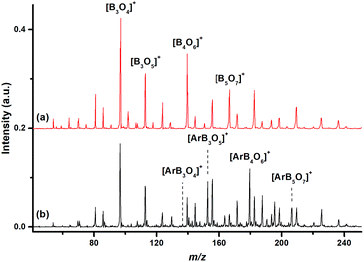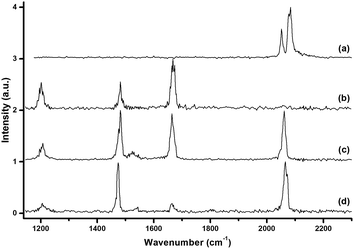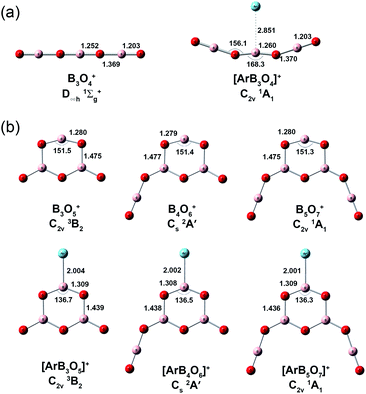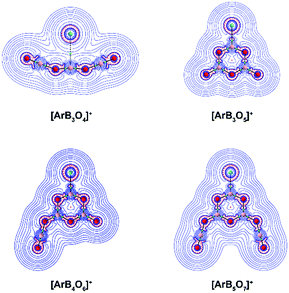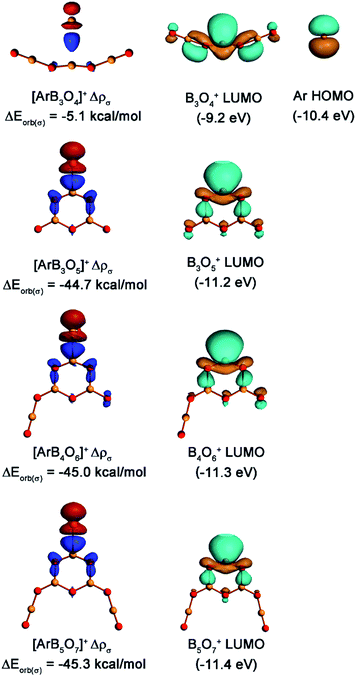 Open Access Article
Open Access ArticleCreative Commons Attribution 3.0 Unported Licence
Preparation and characterization of chemically bonded argon–boroxol ring cation complexes†
Jiaye
Jin
 ,
Wei
Li
,
Yuhong
Liu
,
Guanjun
Wang
and
Mingfei
Zhou
,
Wei
Li
,
Yuhong
Liu
,
Guanjun
Wang
and
Mingfei
Zhou
 *
*
Department of Chemistry, Collaborative Innovation Center of Chemistry for Energy Materials, Shanghai Key Laboratory of Molecular Catalysis and Innovative Materials, Fudan University, Shanghai 200433, China. E-mail: mfzhou@fudan.edu.cn
First published on 17th July 2017
Abstract
The cation complexes [ArB3O4]+, [ArB3O5]+, [ArB4O6]+ and [ArB5O7]+ were prepared via a laser vaporization supersonic ion source in the gas phase. Their vibrational spectra were measured via mass-selected infrared photodissociation spectroscopy. Spectroscopy combined with quantum chemical calculations revealed that the [ArB3O5]+, [ArB4O6]+ and [ArB5O7]+ cation complexes have planar structures each involving an aromatic boroxol ring and an argon–boron covalent bond. In contrast, the [ArB3O4]+ cation is characterized to be a weakly bound complex with a B3O4+ chain structure.
Introduction
The first synthesis of the stable xenon-containing compounds XePtF6, XeF4 and XeF21 inspired great interest in searching for new noble gas compounds to improve our understanding of noble gas chemistry. Since then, many chemically bound compounds containing heavier noble gas atoms have been prepared and structurally characterized, most of them being xenon compounds.2–5 The lighter rare gas argon is even more chemically inert than the heavier noble gas atoms due to its stable valence shell. Although a number of theoretical studies indicate that chemical bonding between argon and other atoms is possible to form some metastable argon-containing compounds,6 HArF is presently the only experimentally known neutral molecule containing a chemically bound argon atom that is stable in a low temperature argon matrix.7 Theoretical calculations indicated that the H–Ar bond in HArF is covalent, whereas the Ar–F bond is mainly electrostatic.8 The bare ArH+ ion has been detected in cosmic dust associated with the Crab Nebula supernova, and is the first noble-gas molecule detected in outer space.9 Argon can act as a Lewis base that is able to coordinate to positively charged metal centers. Complexes containing argon such as ArBeX (X = O, S, or CO3),10,11 ArW(CO)5,12 ArMX (M = Cu, Ag, Au, etc., and X = F, Cl, Br or O),13–15 CUO(Ar)16 and Ar-mixed gold–silver trimer cations17 have been experimentally observed in the gas phase or in low-temperature matrices. Most of the Ar–M interactions in these complexes can be regarded as Lewis acid–base interactions with quite large binding energies (about 5–10 kcal mol−1), but the electron density distribution analyses indicate that they have some dative bonding property instead of normal dative or electron-sharing covalent bonds.18Significant efforts have also been made in searching for chemical bonding between argon and more challenging elements such as boron. Argon–boron containing compounds including FArBO, FArBF2 and FArBN− were theoretically studied, and were predicted to be thermally metastable species with covalent Ar–B bonding.19 Argon coordination complexes including ArBBAr, ArB+, ArBF2+ and B3Ar3+ have also been studied computationally,20–23 and some of them exhibit remarkably strong Ar–B bonding.22,23 Only the BAr+ and ArBF2+ cations as well as the metastable ArBFn2+ dications have been experimentally detected using mass spectrometry in the gas phase.24,25 Here we report the experimental preparation of a group of boron oxide–argon cation complexes in the gas phase. Mass-selected infrared photodissociation spectroscopy and high-level quantum chemical calculation studies reveal strong argon–boron chemical bonding in these cation complexes featuring an aromatic boroxol ring.
Experimental and theoretical methods
The experiment was performed using a collinear tandem time-of-flight mass spectrometer equipped with a pulsed laser vaporization/supersonic expansion cluster ion source that was described in detail previously.26 The cation clusters were produced by pulsed laser (532 nm, Spectral Physics, 10 Hz repetition rate) ablation of a target made of 10B-depleted or 10B-enriched powders (Alfa Aesar, 90–97%). The clusters were entrained by a helium carrier gas seeded with 0.1–1.0% O2 and 5–10% argon at a backing pressure of 0.6–1.2 MPa and underwent a supersonic expansion (General Valve Series 9) to form a collimated and cold molecular beam. The composition and cooling of the cation clusters were controlled by the time delay between the carrier gas pulse and the ablation laser. The cation clusters were extracted and analysed with a time-of-flight mass spectrometer (TOFMS). The ions of interest were mass selected, decelerated and then subjected to infrared photodissociation. The fragment ions together with the undissociated parent ions were reaccelerated and detected by a second collinear TOFMS. IR spectra were recorded by monitoring the relative yield of fragment ions as a function of the photodissociation IR laser wavelength. The infrared dissociation laser was generated by an OPO/OPA system (Laser Vision) pumped by a Continuum Surelite EX Nd:YAG laser, producing tunable infrared light with energies of 0.4–1.0 mJ per pulse in the wavelength range of 1150–2300 cm−1. The spectra were recorded by scanning the dissociation laser in steps of 2 cm−1 and averaging over 400 laser shots at each step.The search for the global minimum structure of the [ArB3O4]+, [ArB3O5]+, [ArB4O6]+ and [ArB5O7]+ cation complexes and the bare [BxOy]+ cation clusters was performed at the B3LYP-D3/aug-cc-pVTZ27–29 level of theory using the Gaussian 09 program30 with the empirical dispersion correction added to increase the accuracy on the long-range force.31 The lowest energy structures were then re-optimized at the CCSD(T)/cc-pVTZ32 level of theory using the MOLPRO 2010 program.33
Chemical bonding analyses were performed by the adaptive natural density partitioning (AdNDP) method,34 quantum theory of atoms in molecules (QTAIM)35 and energy decomposition analysis with natural orbitals of chemical valence (EDA-NOCV).36 AdNDP is a theoretical tool for obtaining patterns of chemical bonding based on the concept of the electron pair as the main element of chemical bonding models. It achieves seamless description of systems featuring both localized and delocalized bonding without invoking the concept of resonance.34 The AdNDP analyses were performed using the Multiwfn program.37 The wave function files generated from CCSD(T) calculations were employed to analyse the topology of the electron density with the AIMALL package.38 The critical points (atom, bond and ring), bond paths, and Laplace distribution of density provided a comprehensive view of the electron density between the boron and argon. The EDA-NOCV bonding was analysed at the BP86/TZ2P39–41 level with the geometries optimized at the CCSD(T) level using the ADF2014.10 program package.42 The EDA-NOCV bonding analysis focuses on the instantaneous interaction energy, ΔEint, of a bond A–B between two fragments, A and B, in the particular electronic reference state and in the frozen geometry of AB. This ΔEint is divided into three main components: the quasiclassical electrostatic interaction energy (ΔEelstat), the Pauli repulsion energy (ΔEPauli) and the orbital interaction (ΔEorb). The ΔEorb accounts for the charge transfer and polarization effects, and is decomposed into contributions from each irreducible representation of the point group for the system.
Results and discussion
The mass spectrum using a 10B-depleted boron target in expansions of helium gas seeded with oxygen in the m/z range of 40–250 is shown in Fig. 1(a). The peaks due to 11B3O4+, 11B3O5+, 11B4O6+ and 11B5O7+ are the most intense peaks in the mass spectrum, in agreement with that reported in the literature.43Fig. 1(b) shows the mass spectrum under the same experimental conditions but with an additional 10% argon seeded in the expansion gas. The 11B3O4+ ion remained the most intense peak, but the relative intensities of the 11B3O5+, 11B4O6+ and 11B5O7+ peaks were highly reduced. The [Ar11B3O5]+, [Ar11B4O6]+ and [Ar11B5O7]+ mass peaks were produced with quite high abundance. Similar spectra were produced using a 10B-enriched target (Fig. S1 of ESI†).The [Ar11B3O4]+, [Ar11B3O5]+, [Ar11B4O6]+ and [Ar11B5O7]+ cations were each mass-selected and subjected to infrared photodissociation. It was found that the [Ar11B3O4]+ cation dissociated via losing the argon atom very efficiently and reached dissociation saturation at a quite low IR laser energy (about 0.5 mJ per pulse, see Fig. S2†). In contrast, the other ions dissociated with very low efficiency with the focused IR laser beam. As shown in Fig. S2,† the dissociation efficiency only reached about 5–6% at the highest available laser energy (1.0 mJ per pulse) at 2062 cm−1 for [Ar11B4O6]+. These observations indicate that [Ar11B3O4]+ is a weakly bound argon-tagged complex,44 while the [Ar11B3O5]+, [Ar11B4O6]+ and [Ar11B5O7]+ cations are more strongly bound. The infrared photodissociation spectra of these ions in the 1150–2300 cm−1 frequency region are shown in Fig. 2. The [Ar11B3O4]+ cation exhibited only two bands in the 2050–2150 cm−1 region, whereas three bands in the 1200–1700 cm−1 region were observed for the [Ar11B3O5]+ cation. The spectra of [Ar11B4O6]+ and [Ar11B5O7]+ in the 1200–1700 cm−1 region are quite similar to that of [Ar11B3O5]+, suggesting that [Ar11B3O5]+ may be the core structure of [Ar11B4O6]+ and [Ar11B5O7]+. All of the bands were blue-shifted in the experiments using the 10B-enriched target (see Fig. S3†). The observed frequency shifts (Table 1) with 10B/11B isotopic ratios in the range of 1.023–1.036 indicate that all of these bands are BO stretching vibrations. The bands above 2050 cm−1 are assigned as stretching vibrations of terminally bonded B![[triple bond, length as m-dash]](https://www.rsc.org/images/entities/char_e002.gif) O fragments; the bands in the range of 1400–1700 cm−1 can be attributed to the vibrations of the aggregated boroxol ring, and the bands near 1200 cm−1 fall into the region of the stretching vibrations of B–O single bonds.45
O fragments; the bands in the range of 1400–1700 cm−1 can be attributed to the vibrations of the aggregated boroxol ring, and the bands near 1200 cm−1 fall into the region of the stretching vibrations of B–O single bonds.45
| Exptl. | Calcd | |||||
|---|---|---|---|---|---|---|
| 11B | 10B | Δ | 11B | 10B | Δ | |
| [ArB3O4]+ | 2144.8(6) | 2217.1(6) | +72.8 | |||
| 2052 | 2120 | +68 | 2123.3(1868) | 2193(1770) | +69.9 | |
| 2084 | 2138 | +54 | 2086.9(1135) | 2162.1(1135) | +75.2 | |
| [ArB3O5]+ | 1668 | 1722 | +54 | 1681.7(684) | 1740.4(707) | +58.7 |
| 1523.6(46) | 1582.3(47) | +58.7 | ||||
| 1482 | 1536 | +54 | 1496.9(595) | 1548.4(663) | +51.5 | |
| 1202 | 1230 | +28 | 1227.9(1119) | 1259.9(1186) | +32.0 | |
| [ArB4O6]+ | 2062 | 2132 | +70 | 2108.8(534) | 2181.6(596) | +72.8 |
| 1664 | 1724 | +60 | 1683.2(581) | 1742.1(604) | +58.9 | |
| 1524 | 1574 | +50 | 1548.0(555) | 1601.5(495) | +53.5 | |
| 1482 | 1528 | +46 | 1495.9(858) | 1546.7(1029) | +50.8 | |
| 1208 | 1240 | +32 | 1234.5(1296) | 1269.2(1350) | +34.7 | |
| [ArB5O7]+ | 2066 | 2130 | +64 | 2114.4(808) | 2187.4(862) | +73.0 |
| 2104.9(236) | 2177.7(250) | +72.8 | ||||
| 1666 | 1722 | +56 | 1684.5(521) | 1743.5(544) | +59.0 | |
| 1544 | 1598 | +54 | 1570.2(386) | 1623.3(401) | +53.1 | |
| 1478 | 1522 | +44 | 1501.6(1824) | 1547.6(1968) | +46.0 | |
| 1206 | 1244 | +38 | 1242.0(1478) | 1279.9(1485) | +37.9 | |
Quantum chemical calculations were carried out to investigate the geometric and electronic structures and the vibrational frequencies of the cation complexes. Fig. 3 shows the optimized geometries of the most stable structures of [ArB3O4]+, [ArB3O5]+, [ArB4O6]+ and [ArB5O7]+ at the CCSD(T)/cc-pVTZ level of theory. Geometric optimizations were also performed on various other possible structures at the B3LYP-D3/aug-cc-pVTZ level, and the results are shown in Fig. S4–S6.† The lowest-lying structure of [ArB3O4]+ was identified as having a 1A1 ground state with planar C2v symmetry involving a B3O4 chain and a weakly tagging argon. The most stable structure of [ArB3O5]+ has a 3B2 ground state with planar C2v symmetry involving a boroxol ring. The argon atom is bound to one boron center of the boroxol ring, while the other two boron centers of the boroxol ring are each bonded by a monovalent O radical. The most stable structure of [ArB4O6]+ can be regarded as being formed via replacing an O radical of [ArB3O5]+ with an OBO fragment, resulting in a 2A′ ground state with planar Cs symmetry. The most stable structure of [ArB5O7]+ has a closed-shell singlet ground state with both O radicals of [ArB3O5]+ replaced by OBO. It should be noted that there are conformational isomers for both [ArB4O6]+ and [ArB5O7]+ (see Fig. S5,† structures 2A and B for [ArB4O6]+, and 3A–C for [ArB5O7]+). These isomers are isoenergetic with similar infrared spectra (Fig. S9 and S10†). Thus, the experimentally observed cations may be due to mixtures of these conformational isomers. As shown in Table 1 and Fig. S7–S10,† the calculated vibrational frequencies and boron isotopic shifts of the most stable structures for these cations were in quite good agreement with the experimental values.
The Ar–B bond distances were predicted to be 2.004, 2.002 and 2.001 Å for the [ArB3O5]+, [ArB4O6]+ and [ArB5O7]+ cation complexes, respectively, at the CCSD(T)/cc-pVTZ level. These Ar–B bond distances are much shorter than the sum of the van der Waals radii of argon and boron (Ar + B = 1.88 + 2.08 = 3.96 Å),46 and are close to the sum of their single-bond covalent radii (Ar + B = 1.81 Å).47 This suggests strong interaction between argon and boron in these cation complexes. The Wiberg bond orders (Table 2) were predicted to be 0.543, 0.545 and 0.547, respectively, slightly smaller than that of the H–Ar bond in HArF.18a The bond dissociation energies (Table 2) of the argon atom were 16.2, 16.3 and 16.4 kcal mol−1 for [ArB3O5]+, [ArB4O6]+ and [ArB5O7]+, respectively, at the CCSD(t)/cc-pVTZ level, which are larger than that of the well-studied [CH3Ar]+ complex.48 The Ar–B bond distance, Wiberg bond order and bond dissociation energy of the [ArB3O4]+ cation complex were predicted to be 2.851 Å, 0.015 and 3.4 kcal mol−1, indicating that the Ar–B interaction in [ArB3O4]+ is much weaker than those in the Ar–boroxol ring cation complexes.
| a The values in brackets give the percentage contribution to the total attractive interactions ΔEelstat + ΔEorb. b The values in parentheses give the percentage contribution to the total ΔEorb. ΔEorb(r) is the rest interaction energy of ΔEorb. | ||||
|---|---|---|---|---|
| Species | Ar–B3O4+(1A1) | Ar–B3O5+(3B2) | Ar–B4O6+(2A′) | Ar–B5O7+(1A1) |
| r(Ar–B) | 2.851 | 2.004 | 2.002 | 2.001 |
| D e | 3.4 | 16.2 | 16.3 | 16.4 |
| ΔEint | −2.3 | −19.7 | −19.5 | −20.4 |
| ΔEPauli | 6.2 | 53.1 | 54.1 | 51.2 |
| ΔEelstata | −1.6[18.8%] | −15.0[20.7%] | −16.1[21.9%] | −14.3[20.0%] |
| ΔEorba | −6.9[81.2%] | −57.8[79.3%] | −57.5[78.1%] | −57.3[80.0%] |
| ΔEorb σb | −5.1(73.9%) | −44.7(77.3%) | −45.0(78.3%) | −45.3(79.1%) |
| ΔEorb πb | −8.6(14.9%) | −9.2(16.0%) | −9.0(15.7%) | |
| ΔEorb(r)b | −1.8(26.1%) | −4.5(7.8%) | −3.3(5.7%) | −3.0(5.2%) |
| Q(Ar) | 0.036 | 0.355 | 0.357 | 0.358 |
| WBI | 0.015 | 0.543 | 0.545 | 0.547 |
Consistent with the large bond dissociation energies, the binding of the argon atom had a strong influence on the geometries of the B3O5+, B4O6+ and B5O7+ cation clusters. Large changes in the bond angles and lengths were observed in the boroxol ring upon argon bonding (Fig. 3 and S5†). The O–B–O angle of the argon coordinated OBO moiety was more acute and the two B–O bonds were slightly longer, while the two adjacent O–B bonds were shorter than those of the bare B3O5+, B4O6+ and B5O7+ cation clusters. Fig. 4 shows a comparison between the experimental IR spectrum of [ArB3O5]+ and the simulated IR spectra with and without argon bonding. It clearly shows that the argon bonding had a significant effect on the IR spectrum of [B3O5]+, particularly on the antisymmetric stretching mode of the argon-coordinated OBO moiety, which was red-shifted by about 180 cm−1 upon argon bonding.
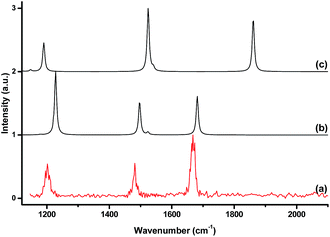 | ||
| Fig. 4 The experimental IR spectrum of [ArB3O5]+ (a) and the simulated IR spectra of [ArB3O5]+ (b) and B3O5+ (c) at the B3LYP-D3/aug-cc-pVTZ level. | ||
To understand the bonding in these cation complexes, AdNDP analysis was carried out (Fig. 5). This method has been successfully used to analyze chemical bonding in boron clusters, aromatic molecules and gold clusters.49 The analyses of [ArB3O5]+, [ArB4O6]+ and [ArB5O7]+ revealed one 2c–2e σ bond with an occupation number (ON) of 1.99 for each cation complex, which was formed between the in-plane 2p atomic orbitals of the argon and boron. No such Ar–B bond can be found in the [ArB3O4]+ cation complex with the chain structure. For each boroxol ring cation complex, there are three 3c–2e delocalized π bonds within the boroxol ring, satisfying the 4n + 2 rule for aromaticity, similar to the B4O4+ cations reported previously.50 Thus, all three boroxol ring cation clusters are π aromatic.
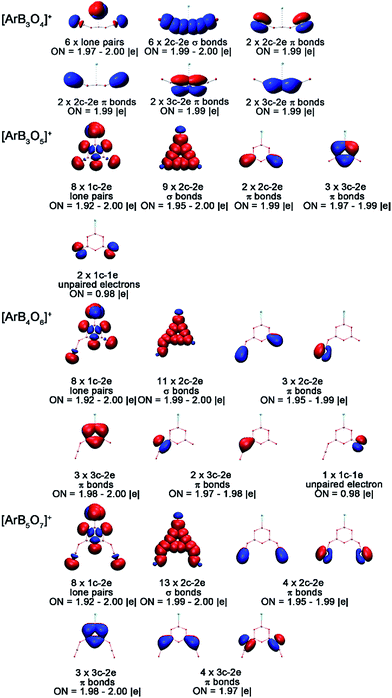 | ||
| Fig. 5 AdNDP bonding orbitals of the [ArB3O4]+, [ArB3O5]+, [ArB4O6]+ and [ArB5O7]+ cation complexes. ON stands for occupation number. | ||
We investigated the topology of the electron density distribution of the species using the quantum theory of atoms in molecules (QTAIM) method.35Fig. 6 shows the Laplacian of the electron density (∇2ρ(r)) of the cation complexes in the molecular plane (the side view is shown in Fig. S11†). There is a bond critical point (∇ρ(r) = 0 and ∇2ρ(r) < 0 in one direction) and an associated bond path for the Ar–B moiety in each cation complex. The Laplacian electron density distribution clearly shows a depletion region (∇2ρ(r) > 0) between argon and boron in [ArB3O4]+ and charge concentration “islands” (∇2ρ(r) < 0, red dashed lines) between boron and argon in the boroxol ring complexes, suggesting a noncovalent Ar–B interaction in [ArB3O4]+ and a genuine Ar–B dative bond in the boroxol ring cation complexes. Natural bond orbital analysis indicated that the argon atom carries positive charges of around 0.36e in the argon–boroxol ring species, but positive charges of only 0.04e in [ArB3O4]+ (Table 2).
The nature of the Ar–B interactions was further analyzed with the EDA-NOCV method,36 which gave detailed insight into the bonding situation. The numerical results of the Ar–B interactions are listed in Table 2. It is quite obvious that the orbital interactions came mainly from the σ donation of argon to the positively charged boron center, which contributes 73.9% of the orbital energy (ΔEorb) in [ArB3O4]+, 77.3% in [ArB3O5]+, 78.3% in [ArB4O6]+, and 79.1% in [ArB5O7]+. The contribution of the π donation was much weaker than the σ donation. Fig. 7 displays the deformation densities Δρ(σ) which are connected to the σ donation interactions (the plots of deformation densities of π orbital interaction are given in Fig. S12†). The color code for the charge flow is red to blue. The shape of the deformation density for [ArB3O4]+ implies that the orbital interaction only caused the charge transfer from argon to the region between argon and boron. This kind of interaction can be considered as an ion-induced weak dipole interaction, as reported previously.18a The shapes of the deformation densities for the [ArB3O5]+, [ArB4O6]+ and [ArB5O7]+ cations indicate that the charge flow comes mainly from the in-plane lone-pair electrons at argon to the BO2 moiety of the boroxol ring, which leads to charge accumulation at the boron atom and the two adjacent O–B bonds (blue region). Note that the interaction energies (ΔEint) and the orbital energies (ΔEorb) of the [ArB3O5]+, [ArB4O6]+ and [ArB5O7]+ cation complexes were smaller than those of the strongly covalent H–Ar bond in HArF, but were much larger than those of the [ArB]+ cation, which has been characterized as involving weak bonding interaction with some covalent or electrostatic properties.18aFig. 7 also displays the pairwise interaction orbitals, the lowest unoccupied molecular orbitals (LUMOs) of bare cations and the highest occupied molecular orbital (HOMO) of argon. Although the LUMO of B3O4+ exhibits very similar spatial distribution to those of the boroxol ring cations, it lies 1.2 and about 2.0 eV higher in energy than the HOMO of argon (−10.4 eV) and the LUMO of the boroxol ring cations (−11.2 to −11.4 eV), respectively. This leads to a much weaker donation interaction in [ArB3O4]+ than those in [ArB3O5]+, [ArB4O6]+, and [ArB5O7]+.
Conclusions
Boron oxide–argon cation complexes in the form of [ArB3O4]+, [ArB3O5]+, [ArB4O6]+ and [ArB5O7]+ were prepared in the gas phase and were mass-selected and studied by infrared photodissociation spectroscopy. Spectroscopy combined with quantum chemical calculations revealed that the [ArB3O4]+ cation is a weakly bound Ar-tagged complex with a B3O4+ chain structure. In contrast, the [ArB3O5]+, [ArB4O6]+ and [ArB5O7]+ cations all have planar structures each involving an aromatic boroxol ring and an argon–boron covalent bond. The [ArB3O5]+, [ArB4O6]+ and [ArB5O7]+ cations reported here represent the very first examples of spectroscopically characterized complexes featuring strong dative bonding between argon and boron that are stable in the gas phase.Acknowledgements
The work was financially supported by the National Natural Science Foundation of China (grant no. 21688102) and the Ministry of Science and Technology of China (2013CB834603 and 2012YQ220113-3).Notes and references
- (a) N. Bartlett, Proc. Chem. Soc., 1962, 6, 218 Search PubMed; (b) H. H. Howard, H. Selig and J. G. Malm, J. Am. Chem. Soc., 1962, 84, 3593 Search PubMed; (c) R. Hope, W. Dähne, W. Rödder and H. Mattauch, Angew. Chem., 1962, 74, 903 CrossRef.
- K. O. Christe, Angew. Chem., Int. Ed., 2001, 40, 1419–1421 CrossRef CAS PubMed.
- R. B. Gerber, Annu. Rev. Phys. Chem., 2004, 55, 55–78 CrossRef CAS PubMed.
- W. Grochala, Chem. Soc. Rev., 2007, 36, 1632–1655 RSC.
- L. Khriachtchev, M. Räsänen and R. B. Gerber, Acc. Chem. Res., 2009, 42, 183–191 CrossRef CAS PubMed.
- (a) P. Pyykkö, Phys. Scr., 1990, T33, 52–53 CrossRef; (b) R. Lindh, W. P. Kraemer and M. Kämper, J. Phys. Chem. A, 1999, 103, 8295–8302 CrossRef CAS; (c) A. Cohen, J. Lundell and R. B. Gerber, J. Chem. Phys., 2003, 119, 6415–6417 CrossRef CAS.
- (a) L. Khriachtchev, M. Pettersson, N. Runeberg, J. Lundell and M. Räsänen, Nature, 2000, 406, 874–876 CrossRef CAS PubMed; (b) G. Frenking, Nature, 2000, 406, 836–837 CrossRef CAS PubMed.
- N. Runeberg, M. Pettersson, L. Khriachtchev, J. Lundell and M. Räsänen, J. Chem. Phys., 2001, 114, 836–841 CrossRef CAS.
- M. J. Barlow, B. M. Swinyard, P. J. Owen, J. Cernicharo, H. L. Gomez, R. J. Ivison, O. Krause, T. L. Lim, M. Matsuura, S. Miller, G. Olofsson and E. T. Polehampton, Science, 2013, 342, 1343–1345 CrossRef CAS PubMed.
- (a) C. A. Thompson and L. Andrews, J. Am. Chem. Soc., 1994, 116, 423–424 CrossRef CAS; (b) G. Frenking, W. Koch, J. Gauss and D. Cremer, J. Am. Chem. Soc., 1988, 110, 8007–8016 CrossRef CAS; (c) A. Veldkamp and G. Frenking, Chem. Phys. Lett., 1994, 226, 11–16 CrossRef CAS.
- (a) Q. Wang and X. F. Wang, J. Phys. Chem. A, 2013, 117, 1508–1513 CrossRef CAS PubMed; (b) Q. N. Zhang, M. H. Chen, M. F. Zhou, D. M. Andrada and G. Frenking, J. Phys. Chem. A, 2015, 119, 2543–2552 CrossRef CAS PubMed; (c) R. Saha, S. Pan, G. Merino and P. K. Chattaraj, J. Phys. Chem. A, 2015, 119, 6746–6752 CrossRef CAS PubMed.
- (a) R. N. Perutz and J. J. Turner, J. Am. Chem. Soc., 1975, 97, 4791–4800 CrossRef CAS; (b) J. R. Wells and E. Weitz, J. Am. Chem. Soc., 1992, 114, 2783–2787 CrossRef CAS.
- (a) C. J. Evans and M. C. L. Gerry, J. Chem. Phys., 2000, 112, 1321–1329 CrossRef CAS; (b) C. J. Evans and M. C. L. Gerry, J. Chem. Phys., 2000, 112, 9363–9374 CrossRef CAS; (c) C. J. Evans, A. Lesarri and M. C. L. Gerry, J. Am. Chem. Soc., 2000, 122, 6100–6105 CrossRef CAS; (d) C. J. Evans, D. S. Rubinoff and M. C. L. Gerry, Phys. Chem. Chem. Phys., 2000, 2, 3943–3948 RSC.
- (a) X. F. Wang, L. Andrews, F. Brosi and S. Riedel, Chem.–Eur. J., 2013, 19, 1397–1409 CrossRef CAS PubMed; (b) X. F. Wang, L. Andrews, K. Willmann, F. Brosi and S. Riedel, Angew. Chem., Int. Ed., 2012, 51, 10628–10632 CrossRef CAS PubMed.
- (a) Y. Y. Zhao, Y. Gong and M. F. Zhou, J. Phys. Chem. A, 2006, 110, 10777–10782 CrossRef CAS PubMed; (b) Y. Y. Zhao, Y. Gong, M. H. Chen and M. F. Zhou, J. Phys. Chem. A, 2006, 110, 1845–1849 CrossRef CAS PubMed; (c) Y. Y. Zhao and M. F. Zhou, Sci. China: Chem., 2010, 53, 327–336 CrossRef CAS.
- (a) J. Li, B. E. Bursten, B. Y. Liang and L. Andrews, Science, 2002, 295, 2242–2245 CrossRef CAS PubMed; (b) B. Y. Liang, L. Andrews, J. Li and B. E. Bursten, Inorg. Chem., 2004, 43, 882–894 CrossRef CAS PubMed; (c) L. Andrews, B. Y. Liang, J. Li and B. E. Bursten, J. Am. Chem. Soc., 2003, 125, 3126–3139 CrossRef CAS PubMed.
- A. Shayeghi, R. L. Johnston, D. M. Rayner, R. Schäfer and A. Fielicke, Angew. Chem., Int. Ed., 2015, 54, 10675–10680 CrossRef CAS PubMed.
- (a) W. L. Zou, D. Nori-Shargh and J. E. Boggs, J. Phys. Chem. A, 2013, 117, 207–212 CrossRef CAS PubMed; (b) D. Himmel, I. Krossing and A. Schnepf, Angew. Chem., Int. Ed., 2014, 53, 370–374 CrossRef CAS PubMed; (c) G. Frenking, Angew. Chem., Int. Ed., 2014, 53, 6040–6046 CrossRef CAS PubMedD. Himmel, I. Krossing and A. Schnepf, Angew. Chem., Int. Ed., 2014, 53, 6047–6048 CrossRef CAS PubMed.
- (a) T. Y. Lin, J. B. Hsu and W. P. Hu, Chem. Phys. Lett., 2005, 402, 514–518 CrossRef CAS; (b) J. L. Chen, C. Y. Yang, H. J. Lin and W. P. Hu, Phys. Chem. Chem. Phys., 2013, 15, 9701–9709 RSC; (c) W. Chen, G. H. Chen, D. Wu and Q. Wang, Phys. Chem. Chem. Phys., 2016, 18, 17534–17545 RSC; (d) P. Antoniotti, S. Borocci, N. Bronzolino, P. Cecchi and F. Grandinetti, J. Phys. Chem. A, 2007, 111, 10144–10151 CrossRef CAS PubMed; (e) A. Sirohiwal, D. Manna, A. Ghosh, T. Jayasekharan and T. K. Ghanty, J. Phys. Chem. A, 2013, 117, 10772–10782 CrossRef CAS PubMed; (f) A. Ghosh, S. Dey, D. Manna and T. K. Ghanty, J. Phys. Chem. A, 2015, 119, 5732–5741 CrossRef CAS PubMed.
- A. Papakondylis, E. Miliordos and A. Mavridis, J. Phys. Chem. A, 2004, 108, 4335–4340 CrossRef CAS.
- (a) A. Ding, J. Karlau, J. Weise, J. Kendrick, P. J. Kuntz, I. H. Hillier and M. F. Guest, J. Phys. Chem., 1978, 68, 2206–2213 CrossRef CAS; (b) G. Frenking, W. Koch, D. Cremer, J. Gauss and J. F. Liebman, J. Chem. Phys., 1989, 93, 3410–3418 CrossRef CAS; (c) M. W. Wong and L. Radom, J. Chem. Phys., 1989, 93, 6303–6308 CrossRef CAS; (d) J. P. Harris, A. M. Gardner, T. G. Wright, W. H. Breckenridge and L. A. Viehland, J. Phys. Chem. A, 2012, 116, 4995–5007 CrossRef CAS PubMed.
- Z. Lv, G. H. Chen, D. Li, D. Wu, X. C. Huang, Z. R. Li and W. G. Liu, J. Chem. Phys., 2011, 134, 154302 CrossRef PubMed.
- R. Saha, S. Pan, S. Mandal, M. Orozco, G. Merino and P. K. Chattaraj, RSC Adv., 2016, 6, 78611–78620 RSC.
- J. T. Koskinen, J. Phys. Chem. A, 1999, 103, 9565–9568 CrossRef CAS.
- (a) L. Levee, C. Calogero, E. Barbieri, S. Byrne, C. Donahue, M. Eisenberg, S. Hattenbach, J. Le, J. F. Capitani, J. Roithová and D. Schröder, Int. J. Mass Spectrom., 2012, 323, 2–7 CrossRef; (b) F. Grandinetti, Eur. J. Mass Spectrom., 2011, 17, 423–463 CrossRef CAS PubMed.
- G. J. Wang, C. X. Chi, X. P. Xing, C. F. Ding and M. F. Zhou, Sci. China: Chem., 2014, 57, 172–177 CrossRef CAS.
- A. D. Becke, J. Chem. Phys., 1993, 98, 5648–5652 CrossRef CAS.
- C. T. Lee, W. T. Yang and R. G. Parr, Phys. Rev. B: Condens. Matter Mater. Phys., 1988, 37, 785–789 CrossRef CAS.
- (a) T. H. Dunning, J. Chem. Phys., 1989, 90, 1007–1023 CrossRef CAS; (b) D. E. Woon and T. H. Dunning, J. Chem. Phys., 1993, 98, 1358–1371 CrossRef CAS.
- M. J. Frisch, G. W. Trucks, H. B. Schlegel, G. E. Scuseria, M. A. Robb, J. R. Cheeseman, G. Scalmani, V. Barone, B. Mennucci, G. A. Petersson, H. Nakatsuji, M. Caricato, X. Li, H. P. Hratchian, A. F. Izmaylov, J. Bloino, G. Zheng, J. L. Sonnenberg, M. Hada, M. Ehara, K. Toyota, R. Fukuda, J. Hasegawa, M. Ishida, T. Nakajima, Y. Honda, O. Kitao, H. Nakai, T. Vreven, J. A. Montgomery Jr, J. E. Peralta, F. Ogliaro, M. Bearpark, J. J. Heyd, E. Brothers, K. N. Kudin, V. N. Staroverov, T. Keith, R. Kobayashi, J. Normand, K. Raghavachari, A. Rendell, J. C. Burant, S. S. Iyengar, J. Tomasi, M. Cossi, N. Rega, J. M. Millam, M. Klene, J. E. Knox, J. B. Cross, V. Bakken, C. Adamo, J. Jaramillo, R. Gomperts, R. E. Stratmann, O. Yazyev, A. J. Austin, R. Cammi, C. Pomelli, J. W. Ochterski, R. L. Martin, K. Morokuma, V. G. Zakrzewski, G. A. Voth, P. Salvador, J. J. Dannenberg, S. Dapprich, A. D. Daniels, O. Farkas, J. B. Foresman, J. V. Ortiz, J. Cioslowski, and D. J. Fox, Gaussian 09, Revision D.01, Gaussian, Inc., Wallingford CT, 2013 Search PubMed.
- S. Grimme, S. Ehrlich and L. Goerigk, J. Comput. Chem., 2011, 32, 1456–1465 CrossRef CAS PubMed.
- P. J. Knowles, C. Hampel and H. J. Werner, J. Chem. Phys., 1993, 99, 5219 CrossRef CAS.
- H.-J. Werner, P. J. Knowles, G. Knizia, F. R. Manby, M. Schütz, P. Celani, W. Györffy, D. Kats, T. Korona, R. Lindh, A. Mitrushenkov, G. Rauhut, K. R. Shamasundar, T. B. Adler, R. D. Amos, A. Bernhardsson, A. Berning, D. L. Cooper, M. J. O. Deegan, A. J. Dobbyn, F. Eckert, E. Goll, C. Hampel, A. Hesselmann, G. Hetzer, T. Hrenar, G. Jansen, C. Köppl, Y. Liu, A. W. Lloyd, R. A. Mata, A. J. May, S. J. McNicholas, W. Meyer, M. E. Mura, A. Nicklass, D. P. O’Neill, P. Palmieri, D. Peng, K. Pflüger, R. Pitzer, M. Reiher, T. Shiozaki, H. Stoll, A. J. Stone, R. Tarroni, T. Thorsteinsson and M. Wang, MOLPRO, version 2010.1 Search PubMed.
- D. Y. Zubarev and A. I. Boldyrev, Phys. Chem. Chem. Phys., 2008, 10, 5207–5217 RSC.
- R. F. W. Bader, Chem. Rev., 1991, 91, 893–928 CrossRef CAS.
- M. P. Mitoraj, A. Michalak and T. Ziegler, J. Chem. Theory Comput., 2009, 5, 962–975 CrossRef CAS PubMed.
- T. Lu and F. W. Chen, J. Comput. Chem., 2012, 33, 580–592 CrossRef CAS PubMed.
- A. K. Todd, AIMAll Version 16.10.31, TK Gristmill Software, Overland Park KS, USA, 2016, http://aim.tkgristmill.com Search PubMed.
- A. D. Becke, Phys. Rev. A, 1988, 38, 3098–3100 CrossRef CAS.
- J. P. Perdew, Phys. Rev. B: Condens. Matter Mater. Phys., 1986, 33, 8822–8824 CrossRef.
- E. Van Lenthe and E. J. Baerends, J. Comput. Chem., 2003, 24, 1142 CrossRef CAS PubMed.
- (a) G. te Velde, F. M. Bickelhaupt, E. J. Baerends, C. F. Guerra, S. J. A. Van Gisbergen, J. G. Snijders and T. Ziegler, J. Comput. Chem., 2001, 22, 931–967 CrossRef CAS; (b) ADF2014, SCM, Theoretical Chemistry, Vrije Universiteit, Amsterdam, The Netherlands, http://www.scm.com Search PubMed.
- R. J. Doyle, J. Am. Chem. Soc., 1988, 110, 4120–4126 CrossRef CAS.
- (a) K. R. Asmis, Phys. Chem. Chem. Phys., 2012, 14, 9270–9281 RSC; (b) A. M. Ricks, Z. E. Reed and M. A. Duncan, J. Phys. Chem. A, 2003, 107, 7396–7405 Search PubMed.
- (a) T. R. Burkholder and L. Andrews, J. Chem. Phys., 1991, 95, 8697–8709 CrossRef CAS; (b) F. A. Miller and C. H. Wilkins, Anal. Chem., 1952, 24, 1253–1294 CrossRef CAS; (c) Y. Gong and M. F. Zhou, J. Phys. Chem. A, 2008, 112, 5670–5675 CrossRef CAS PubMed.
- C. E. Housecroft and A. G. Sharpe, Inorganic Chemistry, Pearson/Prentice Hall, Essex, UK, 3rd edn, 2008 Search PubMed.
- P. Pyykkö and M. Atsumi, Chem.–Eur. J., 2009, 15, 186–197 CrossRef PubMed.
- (a) R. V. Olkhov, S. A. Nizkorodov and O. Dopfer, J. Chem. Phys., 1998, 108, 10046–10060 CrossRef CAS; (b) R. W. Gora, S. Roszak and J. Leszczynski, J. Chem. Phys., 2001, 115, 771–777 CrossRef CAS.
- (a) D. Y. Zubarev and A. I. Boldyrev, J. Org. Chem., 2008, 73, 9251–9258 CrossRef CAS PubMed; (b) D. Y. Zubarev and A. I. Boldyrev, J. Phys. Chem. A, 2009, 113, 866–868 CrossRef CAS PubMed.
- T. Ou, W. J. Tian, X. R. You, Y. J. Wang, K. Wang and H. J. Zhai, Phys. Chem. Chem. Phys., 2015, 17, 29697–29706 RSC.
Footnote |
| † Electronic supplementary information (ESI) available: Mass spectra and IR photodissociation spectra for 10B-enriched species, theoretical geometry optimization and frequency simulations for isomers, and detailed bonding patterns of Ar–B interaction with QTAIM and EDA-NOCV methods. See DOI: 10.1039/c7sc02472j |
| This journal is © The Royal Society of Chemistry 2017 |

